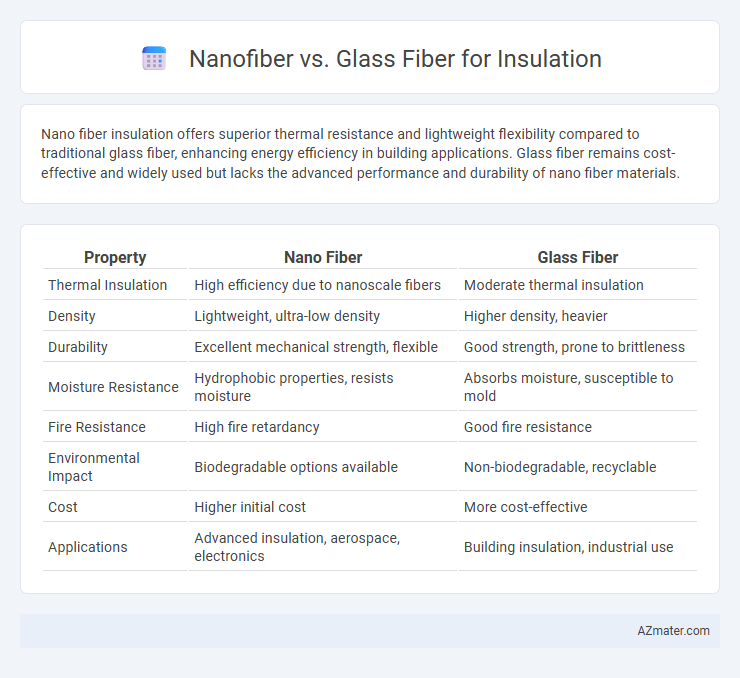Nano fiber insulation offers superior thermal resistance and lightweight flexibility compared to traditional glass fiber, enhancing energy efficiency in building applications. Glass fiber remains cost-effective and widely used but lacks the advanced performance and durability of nano fiber materials.
Table of Comparison
| Property | Nano Fiber | Glass Fiber |
|---|---|---|
| Thermal Insulation | High efficiency due to nanoscale fibers | Moderate thermal insulation |
| Density | Lightweight, ultra-low density | Higher density, heavier |
| Durability | Excellent mechanical strength, flexible | Good strength, prone to brittleness |
| Moisture Resistance | Hydrophobic properties, resists moisture | Absorbs moisture, susceptible to mold |
| Fire Resistance | High fire retardancy | Good fire resistance |
| Environmental Impact | Biodegradable options available | Non-biodegradable, recyclable |
| Cost | Higher initial cost | More cost-effective |
| Applications | Advanced insulation, aerospace, electronics | Building insulation, industrial use |
Introduction to Nano Fiber and Glass Fiber Insulation
Nano fiber insulation offers exceptional thermal performance due to its ultra-fine fiber diameter, which creates numerous tiny air pockets that reduce heat conduction effectively. Glass fiber insulation, composed of fine strands of glass, provides a cost-effective and widely used solution known for good thermal resistance and durability in residential and commercial applications. Advances in nano fiber technology lead to higher insulation efficiency and lightweight properties compared to traditional glass fiber materials.
Composition and Structure of Nano Fibers
Nano fibers for insulation consist of ultra-fine polymer or ceramic strands with diameters typically below 100 nanometers, creating a highly porous structure that significantly enhances thermal resistance. In contrast, glass fibers are composed of spun silica-based glass with larger diameters, resulting in a coarser matrix and less surface area for heat trapping. The nanoscale dimension and interconnected web-like morphology of nano fibers provide superior insulation efficiency compared to traditional glass fiber materials.
Key Characteristics of Glass Fiber Insulation
Glass fiber insulation is composed of fine strands of glass woven into mats or batts, providing excellent thermal resistance with an R-value typically between 2.2 and 2.7 per inch. Its non-combustible nature, low cost, and high sound absorption make it a preferred choice for residential and commercial insulation. Glass fiber also resists moisture and mold growth, ensuring long-term durability in varied environmental conditions.
Thermal Performance Comparison
Nano fiber insulation exhibits superior thermal performance compared to glass fiber due to its ultrafine diameter and high surface area, which significantly reduces heat transfer by minimizing air convection and conduction. The thermal conductivity of nano fiber materials typically ranges from 0.020 to 0.030 W/m*K, markedly lower than the 0.035 to 0.045 W/m*K observed in conventional glass fiber insulation. This enhanced insulating property enables nano fiber composites to achieve better energy efficiency and temperature regulation in residential and industrial applications.
Mechanical Strength and Durability
Nanofibers provide superior mechanical strength due to their high surface area-to-volume ratio, resulting in enhanced tensile strength and flexibility compared to traditional glass fibers. Glass fibers, while offering good durability and resistance to heat and moisture, tend to be more brittle and prone to micro-cracking under mechanical stress. Nanofiber composites exhibit improved impact resistance and longer service life, making them a more durable option in advanced insulation applications where mechanical robustness is critical.
Moisture Resistance and Environmental Stability
Nanofiber insulation offers superior moisture resistance compared to glass fiber, significantly reducing the risk of mold growth and water damage in humid environments. Its high surface area and hydrophobic properties enhance environmental stability, maintaining insulation performance under fluctuating temperature and humidity conditions. Glass fiber insulation, while effective, tends to absorb moisture over time, leading to reduced thermal efficiency and potential degradation in durability when exposed to environmental stressors.
Installation Process and Flexibility
Nano fiber insulation offers superior flexibility compared to glass fiber, making it easier to handle and install in tight or irregular spaces without compromising its performance. The lightweight and pliable nature of nano fiber reduces labor time and the need for specialized cutting tools, enhancing installation efficiency. In contrast, glass fiber is bulkier and more rigid, often requiring protective gear during installation due to irritation risks and resulting in longer, more cumbersome application processes.
Safety and Health Considerations
Nanofiber insulation offers superior safety and health benefits compared to traditional glass fiber, as it generates fewer airborne particles that can cause respiratory irritation or skin irritation. Glass fibers are known for microscopic splinters that may lead to itching, coughing, or long-term respiratory issues, whereas nanofiber materials exhibit reduced fiber shedding and lower toxicity risks. Regulatory bodies often recommend nanofiber insulation in environments demanding stringent air quality control and worker safety protocols.
Cost Efficiency and Market Availability
Nano fiber insulation offers superior thermal performance but comes at a higher production cost compared to traditional glass fiber, impacting overall cost efficiency. Glass fiber remains widely available and affordable, benefiting from established manufacturing infrastructure and large-scale market presence. The cost-effectiveness of glass fiber insulation drives its dominance in mainstream construction markets despite nano fiber's advanced properties.
Future Trends in Fiber-Based Insulation Technologies
Nano fiber insulation offers superior thermal resistance and enhanced durability compared to traditional glass fiber, making it a promising candidate for next-generation energy-efficient buildings. Future trends emphasize the integration of nano fiber composites with smart sensors for real-time environmental monitoring and adaptive insulation performance. Innovations in scalable manufacturing processes aim to reduce costs and environmental impact, positioning nano fibers as a sustainable alternative to glass fiber in fiber-based insulation technologies.

Infographic: Nano fiber vs Glass fiber for Insulation
 azmater.com
azmater.com